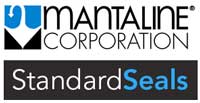Thermoplastic Extrusion
Thermoplastic Extrusions are normally manufactured in a continuous process where thermoplastic raw materials (resins) are continuously fed from a resin hopper into a temperature controlled extruder, where an auger screw propels the fast melting plastic (under pressure) through a die that forms the material into the specific desired profile or shape. This shape then enters a cooling medium; usually air or water. It is conveyed through the cooling medium by way of a puller at the end of the extrusion line which maintains line tension and aids in the overall dimensional stability of the process. This relatively simple process allows for multiple extruders to be linked at the die to provide multi-material profile shapes, where unique material properties can be imparted for the creation of specific applications. Thermoplastic extruded components are typically provided in single, co-, or tri-material constructions.
Thermoplastic resin materials are normally delivered in granular form (pellets) to the extruder, using suction feed systems. Thermoplastic materials can be classified in two primary categories: polar or non-polar, based on specific chemical structure and properties. Traditional polar thermoplastic materials like PVC (polyvinyl chloride), are not chemically compatible with traditional non-polar counterpart materials like olefinic blends including EPR/PP (ethylene propylene rubber/polypropylene).
In recent years, this area of polymer extrusion technology has ‘exploded’ in size and scope of applications over its rubber counterpart. This expansion has been driven by advantages including substantial energy and capitalization savings (from utilization of lower manufacturing temperature requirements), substantially reduced curing (or cooling) times, recyclable offal (process waste and scrap) and easy color matching to end-use applications.
Thermoplastic extrusions are especially well-suited for many transportation and general industry applications. Automotive interiors and exterior applications are replete with durable examples of thermoplastic extruded products that are color matched, textured or laminated, to complement the specific style of the vehicle. The existing uses in home applications that promote thermoplastic extrusions are incalculable. For industrial applications, one only needs to look at grocery store refrigerator seals to see an important use of these versatile materials.
Many thermoplastic materials, owing to their inherent nature, can lose their re-bound or elastic properties when overexposed to excessive heat or thermal conditions. This fact excludes these materials from being an optimal choice in various applications; including dynamic door and sunroof seal applications.



